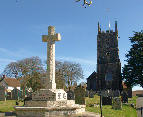We first hear of Albert Pinn in the 1901 census, when he was aged 6, born in 1895. He is listed living in Broadwoodkelly, the grandson of Richard Pinn, a labourer, and his wife Susanna, a glove maker. With them were Richard and Susanna’s family, Anne aged 36, also a glove maker and presumably Albert’s mother, and William aged 34, a labourer. Susanna’s maiden name was Steer, a Winkleigh family. Just before her marriage in 1862 she was living with her family at Rock Hill 3, just outside the village, where her mother was also a glove maker.
The 1911 census records Albert working as a servant for Ford Phillips, a farmer in Broadwoodkelly, employed as a ‘cowman’, (written as ‘carman’ in the census return). However, in November 1914 he enlisted in the Devonshire regiment, as recorded in the Ashreigney Deanery Magazine for that month, which at that early time in the war was listing all those who were volunteering for the armed forces. Sadly, Albert’s army records have not survived the London blitz, but his medal card is particularly interesting and gives us clues to his service. We can see from his army number that he enlisted either in the Devons 1st or 2nd Battalions, or in one of the two Service (Kitchener) Battalions, but the clue comes from the medal card which states that he first went to France on 10th March 1915. Both Service Battalions were still in training at that time, so we can assume that Albert was posted in Mach 1915 either to the 1st or 2nd Battalion. In March 1915 the 1st Battalion had just completed a long tour of duty in front of the Messines Ridge (Nov 1914 to March 1915), and although casualties had been ‘light’ - about 200 for the whole period - large drafts had been received amounting to 24 officers and 850 men, which makes it very possible that Albert was among them. On the other hand, the 2nd Battalion was also a likely candidate for much needed reinforcements, having just taken part in the battle of Neuve Chapelle, 10th – 13th May where casualties were heavy, 10 0fficers and 274 men. The draft which reached the battalion while in ‘rest’ could certainly have included Alfred. The outline records of the 1st and 2nd Battalions then show that Alfred was extremely lucky to survive from March 1915 to November 1917.
1st Battalion
1915
April 21st Hill 60. Held it for 9 days and had 100 casualties.
1916
July to November Somme offensive.
September 4th Leuze wood. Further advance than any other battalion.
September 25th Morval.
1917
April 23rd La Conlotte: asked to do the impossible, 230 casualties.
May 8th/9th Fresnoy: Fought on, when battalion on left and right were late in the attack.
July to October Ypres sector: major attack on the Polderhoek Chateau.
2nd Battalion
1915
March 10th Battle of Neuve Chapelle. 10 Officers and 274 O.R.s casualties
May 9th Battle of Aubers Ridge. Casualties 8 officers and 235 O.R.s
1916
July-November Somme offensive:
.
July 1st First day: Battle of Albert. Battalion destroyed by Machine Gun fire and barrage.
16 Officers and 400 O.R.s casualties.
1917
July to November 3rd Ypres: Battle of Passchendaele.
Survival in either of the battalions for this long period would be regarded as little short of miraculous, so it is likely that much occurred which has been lost to us. The next clue to his whereabouts has been found in The Western Times on 16th November, with the information that Albert had been reported wounded. How serious this was we do not know, or where convalescence too place. There is no mention on the medal card of any transfer to another battalion or, for example, the labour corps or a posting to home service, so he must have recovered well. Albert was demobilised on 21st March 1919, transferred as was usual to the ‘Z’ Reserve.
There is a further clue on the medal card that his wound could not have been crippling. Having been awarded the Victory, British and 1915 Star medals, these were posted to the Metropolitan Police Force on 12th January 1921, where Albert was serving as a Police Constable. Further reconstruction of Albert’s war can only come from family descendents, and it is to be hoped that at some time this may happen. Meanwhile Winkleigh can be proud of the service of a man who obviously made a major contribution to the honour of his country.
